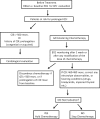ANMCO/AIOM/AICO Consensus Document on clinical and management pathways of cardio-oncology: executive summary
- PMID: 28751851
- PMCID: PMC5520757
- DOI: 10.1093/eurheartj/sux019
ANMCO/AIOM/AICO Consensus Document on clinical and management pathways of cardio-oncology: executive summary
Abstract
Cardiovascular disease and cancer are leading causes of death. Both diseases share the same risk factors and, having the highest incidence and prevalence in the elderly, they often coexist in the same individual. Furthermore, the enhanced survival of cancer patients registered in the last decades and linked to early diagnosis and improvement of care, not infrequently exposes them to the appearance of ominous cardiovascular complications due to the deleterious effects of cancer treatment on the heart and circulatory system. The above considerations have led to the development of a new branch of clinical cardiology based on the principles of multidisciplinary collaboration between cardiologists and oncologists: Cardio-oncology, which aims to find solutions to the prevention, monitoring, diagnosis and treatment of heart damage induced by cancer care in order to pursue, in the individual patient, the best possible care for cancer while minimizing the risk of cardiac toxicity. In this consensus document we provide practical recommendations on how to assess, monitor, treat and supervise the candidate or patient treated with potentially cardiotoxic cancer therapy in order to treat cancer and protect the heart at all stages of the oncological disease. Cardiovascular diseases and cancer often share the same risk factors and can coexist in the same individual. Such possibility is amplified by the deleterious effects of cancer treatment on the heart. The above considerations have led to the development of a new branch of clinical cardiology, based on multidisciplinary collaboration between cardiologist and oncologist: the cardio-oncology. It aims to prevent, monitor, and treat heart damages induced by cancer therapies in order to achieve the most effective cancer treatment, while minimizing the risk of cardiac toxicity. In this paper, we provide practical recommendations on how to assess, monitor, treat and supervise patients treated with potential cardiotoxic cancer therapies.
Keywords: Cancer; Cardio-oncology; Cardiotoxicity; Cardiovascular disease.
Figures



References
-
- Mozaffarian D, Benjamin EJ, Go AS, Arnett DK, Blaha MJ, Cushman M, de Ferranti S, Després JP, Fullerton HJ, Howard VJ, Huffman MD, Judd SE, Kissela BM, Lackland DT, Lichtman JH, Lisabeth LD, Liu S, Mackey RH, Matchar DB, McGuire DK, Mohler ER 3rd, Moy CS, Muntner P, Mussolino ME, Nasir K, Neumar RW, Nichol G, Palaniappan L, Pandey DK, Reeves MJ, Rodriguez CJ, Sorlie PD, Stein J, Towfighi A, Turan TN, Virani SS, Willey JZ, Woo D, Yeh RW. Turner MB; American Heart Association Statistics Committee and Stroke Statistics Subcommittee. Heart disease and stroke statistics—2015 update. A report from the American Heart Association. Circulation 2015;131:e29–322. - PubMed
-
- Eyre H, Kahn R, Robertson RM, Clark NG, Doyle C, Hong Y, Gansler T, Glynn T, Smith RA, Taubert K, Thun MJ.. American Cancer Society; American Diabetes Association American Heart Association. Preventing cancer, cardiovascular disease, and diabetes: a common agenda for the American Cancer Society, the American Diabetes Association, and the American Heart Association. Circulation 2004;109:3244–3255. - PubMed
-
- Truong J, Yan AT, Cramarossa G, Chan KK.. Chemotherapy-induced cardiotoxicity: detection, prevention, and management. Can J Cardiol 2014;30:869–878. - PubMed
LinkOut - more resources
Full Text Sources
Other Literature Sources
Medical
